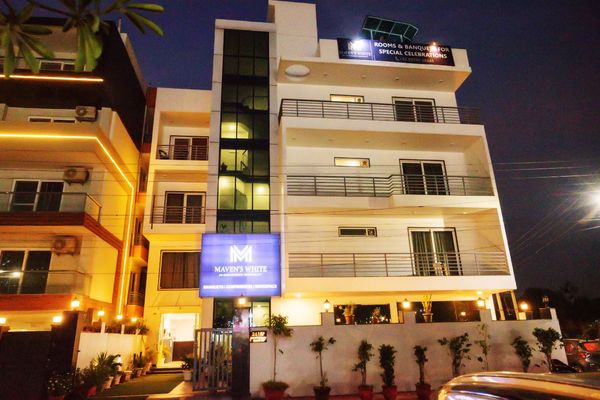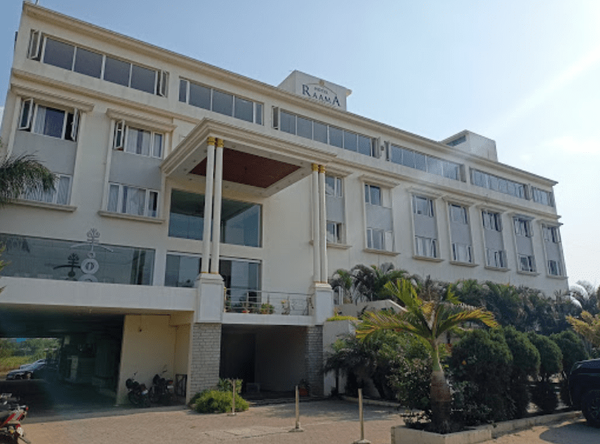Top 10 Best & Toughest Treks in India for Experienced Trekkers
 Mountains Curve
12 Aug, 2025
37 mins read
78
Mountains Curve
12 Aug, 2025
37 mins read
78

India's vast Himalayan belt offers treks that can challenge even the most seasoned adventurers. These trails are not just about walking in high-altitude terrain  they demand mental resilience, technical climbing skills, and survival instincts in extreme weather. If you think you have conquered the easy and moderate treks, these expeditions will test your limits.
Below is a detailed guide to the 10 toughest treks in India, followed by other equally challenging trails, safety measures, fitness requirements, and FAQs.
1. Audens Col Trek, Gangotri, Uttarakhand
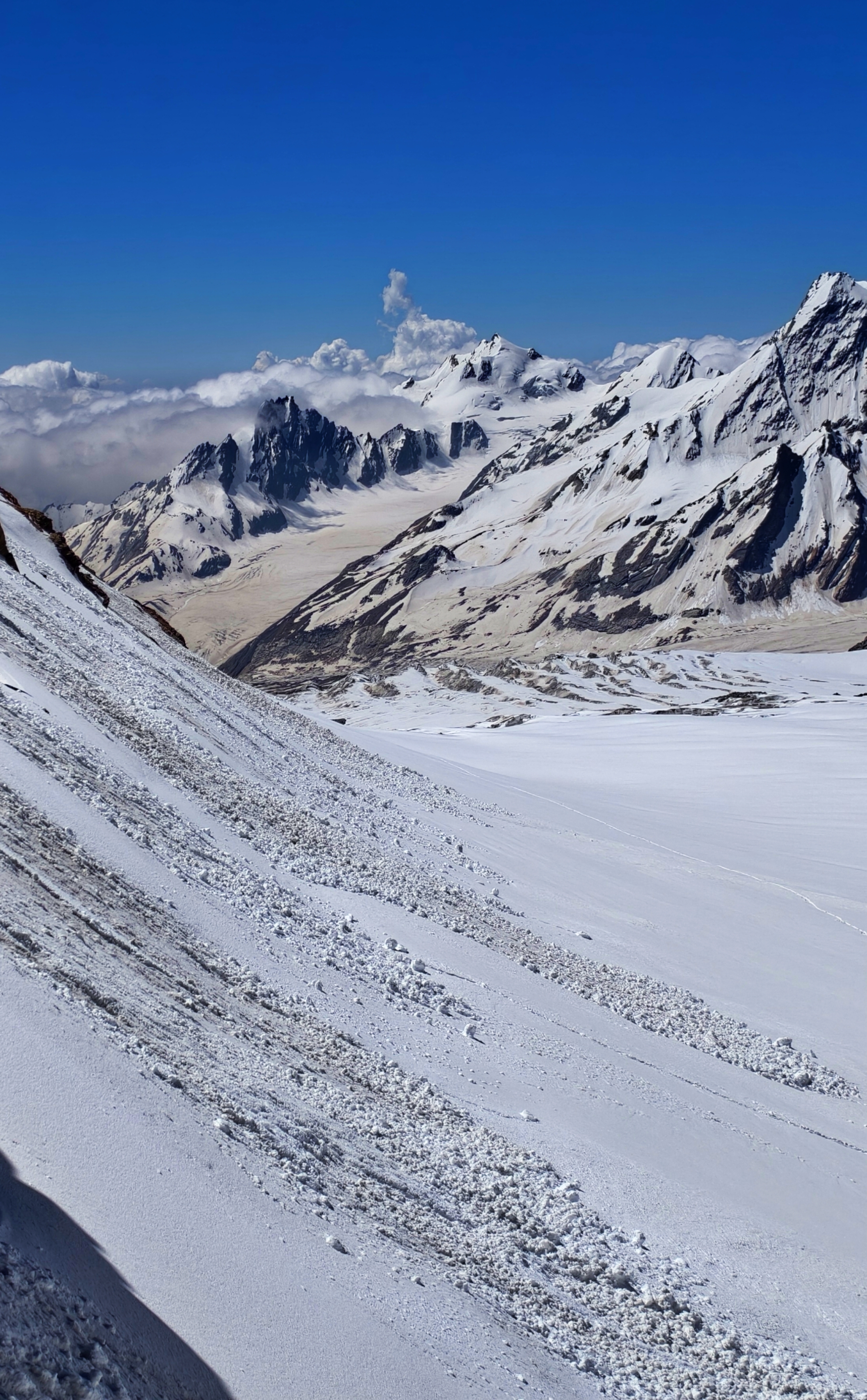
Auden’s Col is one of the toughest and most thrilling high-altitude treks in the Garhwal Himalayas of Uttarakhand. Located at an altitude of 5,460 m (17,913 ft), this glacial corridor separates the Jogin I and Gangotri III peaks and connects the Rudugaira Valley to the Khatling Glacier. Discovered in 1939 by geologist and explorer John Bicknell Auden, the pass was first crossed from the Rudugaira side to Kedarnath—earning it a unique place in both Indian mountaineering history and literature.
The trek begins in the spiritual town of Gangotri and ends in Kedarnath, making it a rare route that links two of the Char Dham pilgrimage sites. Over 15–16 days and roughly 95 km, the trail takes you through meadows, crystal-clear lakes like Sukhatal, Masar Tal, and Vasuki Tal, and breathtaking river valleys of Rudugaira and Bhilangna. Early campsites rest on lush grasslands, while the higher sections challenge you with steep ridges, thick snow, loose rocks, and massive crevasses—especially on the descent from Auden’s Col towards Khatling Glacier.
The journey also includes crossing the remote Mayali Pass, walking past frozen lakes, and navigating glacier fields, all under the watch of towering Himalayan peaks. Though extremely challenging, the trek rewards you with unmatched alpine beauty and the spiritual finale of reaching Kedarnath.
Quick Facts-
- Suitable for: mountaineering enthusiasts and experienced trekkers
- Total Trek Distance: 95 kilometers (Gangotri to Kedarnath)
- Trek Duration: 15 to 16 days
- Highlight: Gangotri, Rudugaira Valley, Auden’s Pass, Khatling Glacier, Masar Tal, Mayali Pass, Vasuki Tal, and Kedarnath
2. Kalindi Khal Trek, Gangotri, Uttarakhand
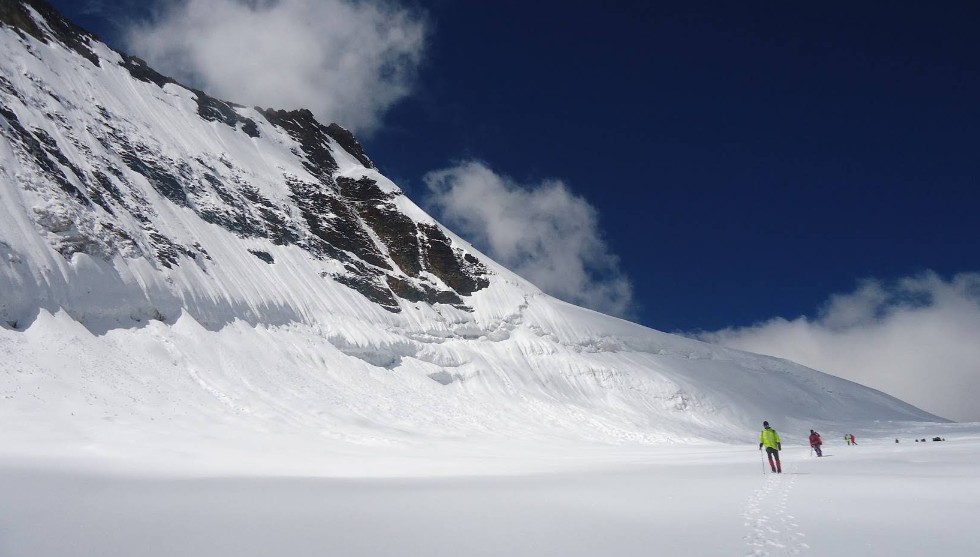
Kalindi Khal Trek is one of the most challenging high-altitude expeditions in the Garhwal Himalayas, linking the sacred shrines of Gangotri and Badrinath through the lofty 5,942-meter Kalindi Khal Pass. This 86-kilometer route takes trekkers across massive glaciers, deep crevasses, rocky moraines, and snowfields where ice axes, crampons, and roped travel are often essential. Traversing from the Bhagirathi Valley to the Alaknanda Valley, the trail rewards adventurers with awe-inspiring views of iconic Himalayan peaks like Shivling, Meru, Kedar Dome, Nilkantha, Kamet, and Mana. The journey also reveals glacial lakes, high-altitude wildlife, and the raw beauty of uncharted mountain terrain. Undertaken from mid-June to mid-September, this expedition demands exceptional endurance and adaptability, making it ideal for seasoned trekkers seeking a true test of skill and spirit in the heart of the Indian Himalayas.
Quick Facts:
- Altitude: 5,942 m (19,495 ft)
- Duration: 12–15 days
- Total Distance: ~86 km
- Highlights: Connects Gangotri to Badrinath, crosses massive glaciers and deep crevasses, panoramic views of peaks like Shivling, Meru, Kamet, and Nilkantha, remote high-altitude lakes and untouched Himalayan wilderness.
3. Lamkhaga Pass Trek, Harsil, Uttarakhand
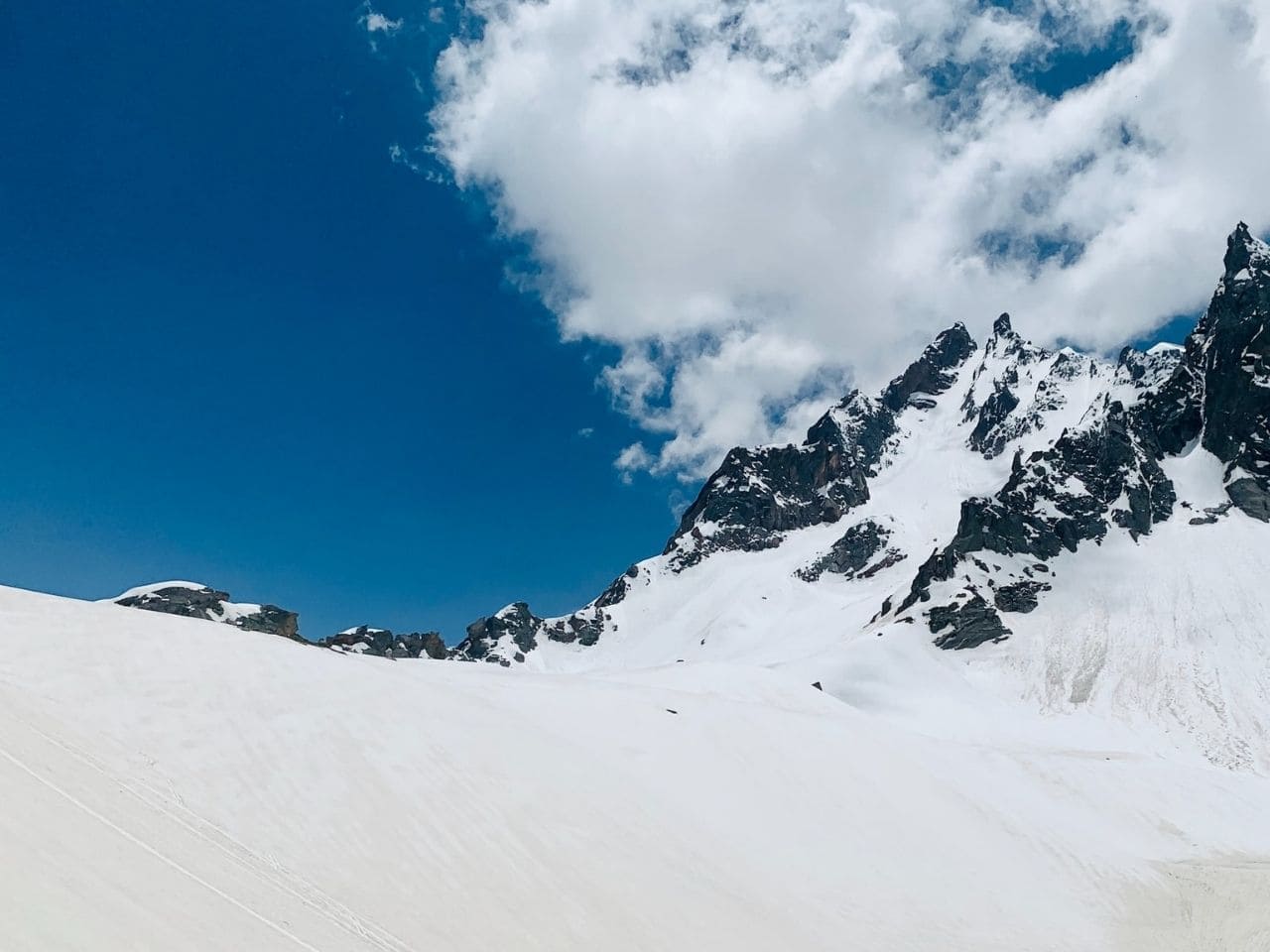
Lamkhaga Pass Trek, standing at 5,282 meters (17,320 feet), is among the most challenging and remote high-altitude crossings in India. This historic route links the scenic Harshil Valley near Uttarkashi in Uttarakhand with the picturesque village of Chitkul in Kinnaur, Himachal Pradesh, offering a rare journey that transitions between two Himalayan states. The trail passes through rugged glaciers, steep rocky slopes, and vast snowfields, demanding exceptional endurance, physical fitness, and prior trekking experience. Situated near the Indo-Tibetan border, the region holds both ecological significance and strategic importance. Along the way, trekkers are rewarded with breathtaking views of towering peaks, pristine valleys, and diverse landscapes that shift from alpine meadows to barren high-mountain terrain. Known for its remoteness and raw beauty, Lamkhaga Pass is a true test of skill and resilience, ideal for seasoned adventurers seeking an unforgettable Himalayan challenge.
Quick Facts
- Altitude: 5,282 m (17,320 ft)
- Duration: 9–11 days
- Total Distance: ~90 km
- Highlights: Connects Harshil in Uttarakhand to Chitkul in Himachal Pradesh, crosses rugged glaciers and snowfields, stunning views of high Himalayan peaks, remote trail near the Indo-Tibetan border.
4. Panpatia Col Trek, Badrinath, Uttarakhand
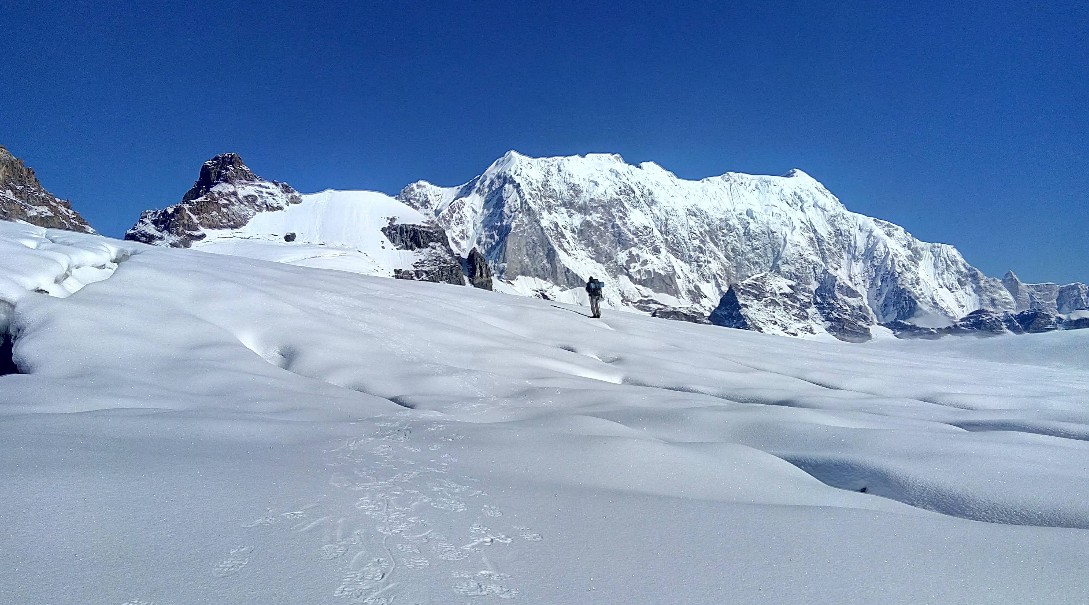
Panpatia Col Trek, rising to 5,260 meters (17,260 feet), is one of the toughest and least traversed high-altitude crossings in the Garhwal Himalayas. This formidable route connects the sacred shrines of Kedarnath and Badrinath, leading trekkers through a dramatic landscape of massive glaciers, crevassed snowfields, steep rocky moraines, and the legendary 7-kilometer-long Panpatia snowfield. Flanked by two unnamed 5,500-meter-plus peaks, the pass offers unmatched views of Nilkantha, Balakun, Sri Parvat, Kunaling, Hathi Parvat, and the Dhauliganga peaks. The expedition demands prior high-altitude trekking experience, technical skills with ice axes and crampons, and exceptional physical and mental endurance. With its remote terrain, challenging conditions, and spiritual significance, Panpatia Col stands as a dream challenge for seasoned trekkers and aspiring mountaineers seeking one of the most rewarding and intense adventures in the Indian Himalayas.
Quick Facts
- Altitude: 5,260 m (17,260 ft)
- Duration: 12–14 days
- Total Distance: ~78 km
- Highlights: Connects Kedarnath to Badrinath, crosses the 7 km long Panpatia snowfield, offers views of Nilkantha, Balakun, and Hathi Parvat, demands advanced technical skills and high endurance.
5. Stok Kangri Trek, Ladakh

Stok Kangri, at 6,153 meters (20,187 feet), is the highest peak in the Stok Range of the Zanskar Mountains, nestled in the breathtaking landscapes of Ladakh. Located within Hemis National Park, this iconic summit offers panoramic views of the Zanskar and Indus Valleys, making it a dream destination for trekkers worldwide. The journey begins near the village of Stok, close to Leh, and takes adventurers through barren yet stunning Trans-Himalayan terrain, ridgelines, and high-altitude valleys that shift dramatically in scenery. Often considered a non-technical introduction to mountaineering, Stok Kangri still demands careful acclimatization, physical endurance, and mental resilience. Its remote beauty, especially in winter when the landscape turns pristine white, offers an unparalleled sense of peace and isolation. Combining accessibility with the thrill of a Himalayan summit, Stok Kangri remains one of India’s most sought-after high-altitude trekking challenges.
Quick Facts
- Altitude – 6,153 meters (20,187 feet)
- Duration – 7 to 9 days
- Total Distance – Around 40 kilometers round trip
- Highlights – Highest peak in the Stok Range, panoramic views of Zanskar & Indus Valleys, challenging high-altitude ascent, diverse Trans-Himalayan landscapes
6. Kang Yatse II Expedition, Ladakh

Kang Yatse II, standing at 6,250 meters, is one of Ladakh’s highest trekking peaks and a crown jewel of the Markha Valley. Located in Hemis National Park, this striking summit offers panoramic views of the Zanskar, Karakoram, and Ladakh ranges. The trek begins in Leh, leading through the surreal landscapes of Markha Valley, dotted with traditional Ladakhi villages like Skiu and Sara, ancient monasteries, and vibrant cultural heritage. Trekkers cross high passes such as Kongmaru La, encounter unique wildlife like blue sheep and marmots, and camp under starlit skies often adorned by the Milky Way. The summit push introduces basic mountaineering skills, with hands-on use of ropes, crampons, and snow gear. Combining breathtaking beauty, challenging high-altitude terrain, and the warm hospitality of Ladakh, Kang Yatse II offers a true Himalayan expedition experience for seasoned trekkers seeking both adventure and culture.
Quick Facts
- Altitude: 6,250 meters (20,505 feet)
- Duration: 10–12 days
- Total Distance: Around 75–80 km
- Highlights: Summit of one of Ladakh’s highest trekking peaks, views of Zanskar, Karakoram, and Ladakh ranges, Markha Valley villages, high passes like Kongmaru La, wildlife sightings, and cultural immersion in Ladakh.
7. Nanda Devi East Base Camp, Munsiyari, Uttarakhand
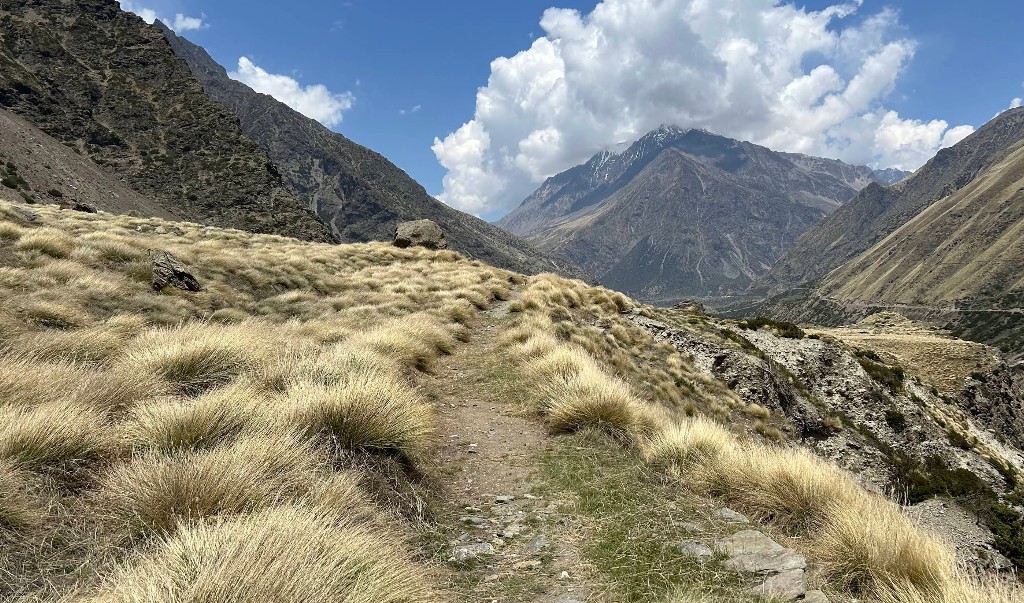
Nanda Devi East Base Camp Trek, at the foot of the 7,434-meter Nanda Devi East peak, offers a rare opportunity to witness India’s second-highest mountain up close. Starting from the picturesque hamlet of Munsiyari, the route unfolds through the Ramganga and Saryu valleys, charming Johari tribe villages, and forests rich in Himalayan flora and fauna. The trek approaches via the dramatic Rishi Ganga gorge, one of the deepest in the world, and eventually opens to breathtaking views of the twin Nanda Devi peaks encircled by a wall of lofty summits. While the initial stages are relatively gentle, the trail grows increasingly challenging, requiring endurance and preparation, especially for those attempting the nearby Longstaff Col. Passing waterfalls, meadows, and glaciers, and with chances to spot rare wildlife like snow leopards or musk deer, this trek is a true Himalayan classic for seasoned adventurers.
Quick Facts
- Altitude: 4,150 meters (13,615 feet) at base camp
- Duration: 9–12 days
- Total Distance: Around 80–90 km
- Highlights: Close-up views of Nanda Devi twin peaks, trek through Johari tribe villages, Ramganga and Saryu valleys, Rishi Ganga gorge, alpine meadows, waterfalls, glaciers, and rare Himalayan wildlife sightings.
8. Rumtse to Tso Moriri Trek, Ladakh
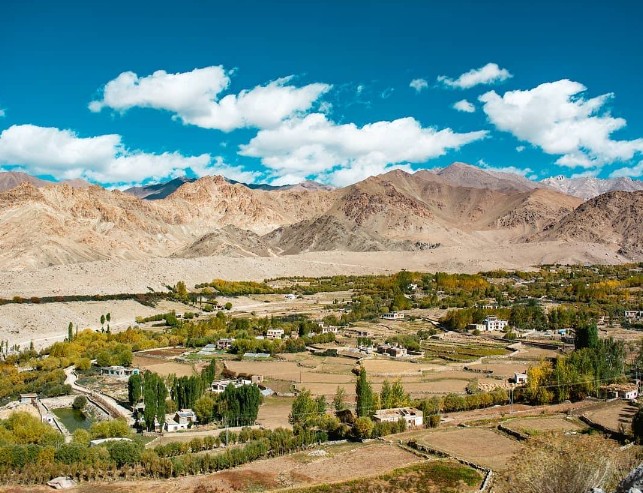
The Rumtse to Tso Moriri Trek is a challenging 100-kilometer journey through the remote and pristine Changthang Valley of Ladakh, reaching altitudes of up to 17,840 feet. Starting near Leh at 11,562 feet, the trail crosses six high passes over 5,000 meters and passes three stunning high-altitude lakes, including the breathtaking Tso Moriri. Known as a “four-season trek†for its constantly shifting landscapes, trekkers experience snow-clad peaks, lush green campsites, meandering rivers, and barren rainbow-colored mountains. The route demands exceptional fitness, acclimatization, and endurance, with long walking days, steep ascents, and rugged descents. Wildlife enthusiasts may spot wild asses, blue sheep, marmots, and even the elusive snow leopard. Along the way, encounters with Changthang nomads and their pashmina goats and yaks add cultural depth to the adventure. This trek is a true test of resilience, offering unmatched beauty and raw Himalayan wilderness.
Quick Facts
- Altitude – Highest point at 17,840 feet (5,438 meters)
- Duration – 8 to 9 days
- Total Distance – Around 100 kilometers
- Highlights – Six high mountain passes, three high-altitude lakes including Tso Moriri, diverse landscapes from snow peaks to rainbow mountains, Changthang nomad culture, and rare wildlife sightings
9. Dhumdhar Kandi Pass, Sankri, Uttarakhand
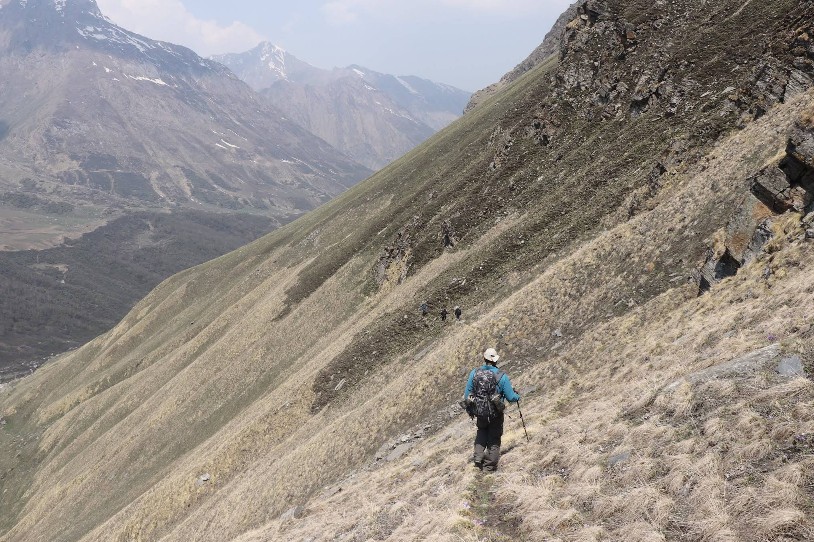
Dhumdhar Kandi Pass Trek, at 5,490 meters (18,012 feet), is a legendary and challenging high-altitude route in the Garhwal Himalayas that connects the Gangotri and Yamunotri regions. Historically used by villagers, traders, and even invaders to access the remote Tons Valley, the pass was first successfully crossed in 1987. This unique trek is flanked by glaciers that feed two great riversâ€â€the Bhagirathi and the Yamunaâ€â€and lies at the base of the iconic peaks Kalanag and Swargarohini. The journey begins near Jhala village, following the Sian Gad valley before crossing vast snowfields and descending into the Kalanag Icefall and Bandarpoonch Glacier. Along the way, trekkers pass lush meadows, high mountain villages, and witness stunning views of Banderpunch, Yellow Tooth, and Swargarohini. With its complex terrain, unpredictable weather, and technical challenges, this trek is reserved for experienced mountaineers seeking an untamed Himalayan adventure.
Quick Facts
- Altitude – 5,490 meters (18,012 feet)
- Duration – 10 to 12 days
- Total Distance – Around 90 kilometers (varies with route)
- Highlights – Historic high-altitude trade route, glaciers feeding Bhagirathi & Yamuna rivers, base of Kalanag & Swargarohini, panoramic views of Banderpunch, Yellow Tooth, and untouched Himalayan meadows
10. Parang La, Ladakh
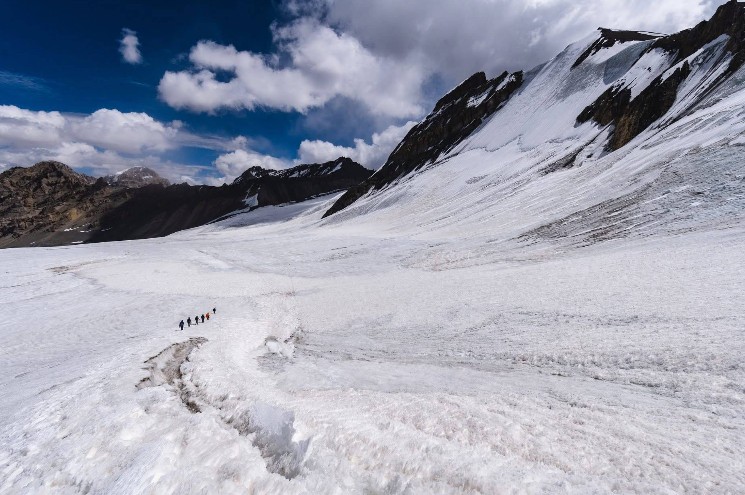
Parang La trek is an ancient trade route between the Spiti in Himachal, Tibet & Changthang in Ladakh region. Parang La trek can be started from either Karzok village in Leh or from Chicham / Kibber village in Spiti. The trail takes you to a maximum altitude of around 5600 meters to Parang La & follows the Pare Chu river which goes to Tibet & re-enters India. The main attraction of the trail is the old yet dynamic mountain features which resemble a unique pattern of being under the sea for a long time & houses some of the unique fossils. The trail has vast meadows which were a grazing ground for horses from Spiti Valley. The most amazing part of the trek is the walk along the Tso Moriri Lake for complete 2 days where the lake offers different shades of blue with many unclimbed peaks in the background. The endpoint is Karzok village which houses one of the old & powerful monasteries in Leh. Stay on this page for more information like - Parang la trek itinerary, route map, weather and temperature conditions, photos, videos, and reviews. Scroll to the end to read some amazing Parang La trek blogs.
Quick Facts
- Altitude: 5600 m
- Duration: 9–12 days
- Total Distance: ~115 km
- Highlights: Ancient trade route between Spiti, Tibet, and Ladakh, fossils and unique sea-bed-like mountain patterns, vast grazing meadows, two-day walk along Tso Moriri Lake with changing shades of blue, and visit to Karzok Monastery.
Other Extremely Difficult Treks in India
While the treks above often dominate the conversation, there are several other routes in India that rival them in difficulty. These demand equal levels of endurance, skill, and mental strength.
1. Pin Parvati Pass Trek – The High-Altitude Gateway to Spiti
- Region: Himachal Pradesh
- Altitude: 5,319 m
- Duration: 10–12 days
The Pin Parvati Pass trek connects the lush Parvati Valley in Kullu to the barren Pin Valley in Spiti. Trekkers face long glacier walks, unpredictable weather, and steep climbs above 5,000 m. The transition from green valleys to stark desert landscapes is both breathtaking and mentally exhausting.
2. Goechala Trek via Kanchenjunga Base – Eastern Himalayan Challenge
- Region: Sikkim
- Altitude: 4,940 m
- Duration: 10–12 days
This trek takes you to the closest viewpoint of Mount Kanchenjunga, the third-highest peak in the world. Apart from steep ascents and rugged forest trails, the biggest challenge is the altitude and cold temperatures in the pre-dawn summit push to Goechala.
3. Bara Bhangal Trek – The Shepherd’s Forbidden Route
- Region: Himachal Pradesh
- Altitude: 4,800 m
- Duration: 10–12 days
Connecting Kangra Valley to the remote village of Bara Bhangal, this trek involves crossing two high passes  Thamsar La and Kaliha Top. The trail is wild, rarely used, and demands multiple river crossings, steep climbs, and navigation through glacier-fed streams.
4. Everest Base Camp via Gokyo Ri – The Alternate High-Altitude Path
- Region: Nepal (accessed from India)
- Altitude: 5,364 m (Base Camp), 5,357 m (Gokyo Ri)
- Duration: 14–16 days
While Everest Base Camp is iconic, doing it via Gokyo Ri adds an extra layer of challenge  multiple high passes, steep climbs, and longer days at altitude. The reward is panoramic views of Everest, Lhotse, Makalu, and Cho Oyu.
5. Siachen Glacier Trek – March on the World’s Highest Battlefield
- Region: Ladakh (Restricted Zone)
- Altitude: 5,400 m
- Duration: 8–10 days (special permits only)
Not open for general tourism, the Siachen Glacier trek is undertaken mostly by military expeditions or special civilian programs. Apart from extreme cold and thin oxygen, trekkers face the challenge of walking on crevasse-riddled ice for days.
6. Markha Valley with Kang Yatse Summit – From Desert to Ice
- Region: Ladakh
- Altitude: 6,250 m (Kang Yatse II summit)
- Duration: 12–14 days
This trek begins in the arid Markha Valley and ends with the technical climb to Kang Yatse II. The sudden shift from dry desert terrain to icy, rope-assisted summit attempts makes it a unique yet difficult expedition in the Indian Himalayas.
Safety Precautions Before Going on a Difficult Trek
- Always trek with a certified guide or agency for high-altitude routes
- Carry proper mountaineering gear  crampons, ice axe, ropes, gaiters
- Acclimatize for at least 2–3 days before starting the trek
- Monitor weather forecasts and avoid risky conditions
- Pack emergency medicines including AMS (Acute Mountain Sickness) drugs
- Learn basic rope techniques and glacier rescue skills
- Maintain hydration but avoid overconsumption of water at once
- Carry high-calorie, easy-to-cook food items
- Keep a satellite phone or GPS device for remote communication
- Never rush; follow the “climb high, sleep low†principle
- Inform family and authorities of your trek route in advance
- Wear layered clothing suitable for sub-zero temperatures
Physical Fitness for These Treks
Tough treks require:
- Cardiovascular endurance for long hours of steep ascents and descents
- Muscular strength to carry a heavy backpack over rough terrain
- Flexibility to handle awkward climbs and glacier crossings
- Mental toughness to face extreme weather and isolation
How to prepare:
- Start training at least 3–4 months in advance
- Jog or cycle 5–10 km daily to build stamina
- Add stair climbing with a weighted backpack
- Practice squats, lunges, and planks for leg and core strength
- Go on short hikes every weekend to simulate conditions
- Include breathing exercises for high-altitude adaptation
Conclusion
These treks are not for the faint-hearted  they demand skill, patience, and grit. Whether it’s crossing deadly glaciers, battling freezing winds, or spending nights at altitudes where oxygen is scarce, these adventures are the ultimate test for a trekker’s spirit. If you are ready, trained, and determined, the Himalayas will reward you with experiences beyond imagination.
FAQs – Tough Treks in India
1. Which is the toughest trek in India?
Kalindi Khal is often considered the toughest due to extreme altitude, glacier crossings, and remote location.
2. Can beginners attempt these treks?
No, these treks are for experienced trekkers with prior high-altitude experience.
3. What is the highest trekking peak in India?
Stok Kangri at 6,153 m (currently restricted) was the highest trekkable peak.
4. Do I need special permits?
Yes, many of these treks require permits from local authorities or forest departments.
5. What is the best season for tough Himalayan treks?
Generally, June–September for Ladakh and Spiti; May–June & September–October for Uttarakhand and Himachal.
6. How do I prepare physically for these treks?
Train for at least 3 months with cardio, strength, and endurance exercises.
7. What gear is essential?
Mountaineering boots, crampons, ice axe, thermal layers, down jacket, and a sturdy backpack.
8. What is Acute Mountain Sickness?
A condition caused by reduced oxygen at high altitudes, leading to headaches, nausea, and dizziness.
9. Can I do these treks solo?
Not recommended; most require technical support and safety equipment.
10. Are there rescue facilities?
Only limited in remote areas; evacuation can be slow and costly.
11. What’s the average cost for such treks?
Between ₹50,000 to ₹1,50,000 depending on location, duration, and support needed.
12. Do I need technical climbing skills?
Yes, most involve glacier, ice, or rope climbing techniques.
13. Is travel insurance necessary?
Highly recommended, especially one that covers high-altitude trekking.
14. Are there age restrictions?
No fixed rule, but most agencies require participants to be above 18 and medically fit.
15. Which is the most scenic difficult trek?
Many argue Nanda Devi East Base Camp for its raw, untouched beauty.
window.NREUM||(NREUM={});NREUM.info={"beacon":"bam.nr-data.net","licenseKey":"NRJS-3109bb2e2783f515265","applicationID":"558315209","transactionName":"blUHbEVQCxECBUVQWVcfMEpeHhARBhRCFlRVXwIXVEMAAxcDU1VZXh4VUEc=","queueTime":0,"applicationTime":125,"atts":"QhIEGg1KGB8=","errorBeacon":"bam.nr-data.net","agent":""}
Written By:
Mountains Curve



Hotels at your convenience
Now choose your stay according to your preference. From finding a place for your dream destination or a mere weekend getaway to business accommodations or brief stay, we have got you covered. Explore hotels as per your mood.
